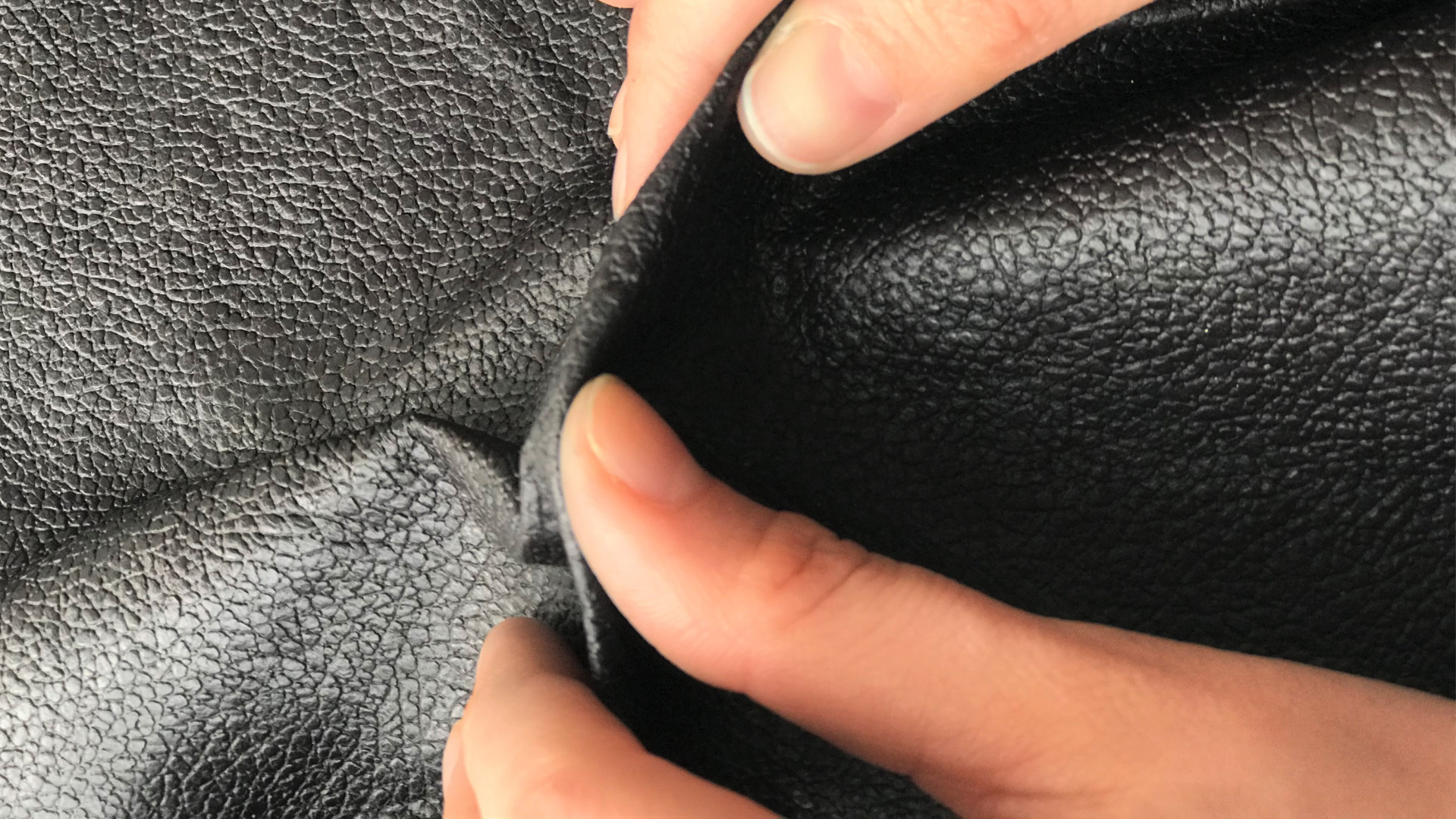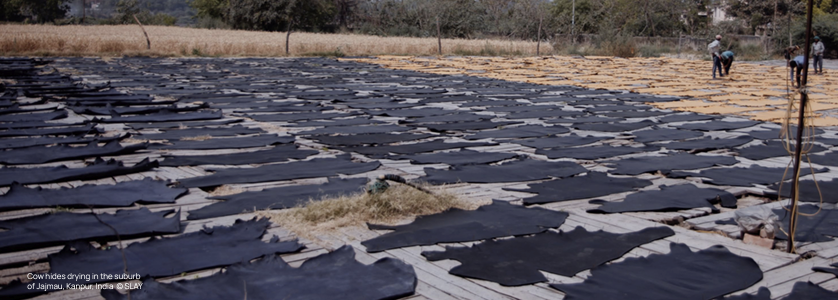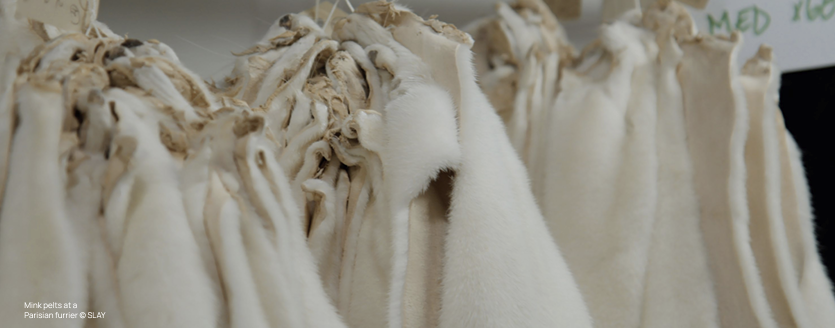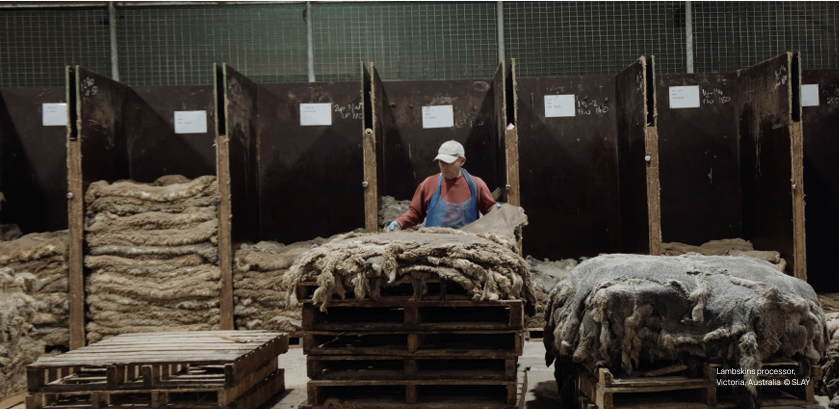Key Takeaways
- The global leather goods market is estimated at US $250B.
- Approximately 1 billion + cattle are raised for slaughter on earth currently; 100 million animals are killed for fur every year.
- Leather is not a waste-diverting product, it is a co-product of the meat industry.
- Manufacturing jobs in leather and fur pose serious health risks to workers, even in the EU.
- Leather, Fur and Wool processing requires large amounts of harsh and toxic chemicals. These affect workers, the environment and even persist in finished products.
- Current innovation in next-gen materials aims to replace incumbent ones with environmentally-preferred, high-quality options.
Introduction
Animal materials like leather, wool and fur are seen as appealing and sustainable natural materials by many consumers. But recent investigations into these billion dollar industries, such as in the 2022 documentary Slay, have put question marks over their perceived ethical and sustainable statuses and their place in the modern materials industry. Here we explore the main environmental, human and animal problems in the production of leather, fur and wool as covered in Slay. This therefore doesn’t cover silk, down, cashmere, exotic skins and feathers, and only covers the most notable issues with each material. Read on for an overview of the harm caused by these industries and what solutions next-gen materials can provide.
Leather – The Toxic Money Maker
The global leather goods market is estimated at between US$250 billion and US$407 billion and is projected to grow to US$743.50 by 2030. Leather is the most commonly used animal material in the fashion industry and quite literally the “cash cow” for luxury brands. For Hermès, leather accounts for 50% of revenue. For brands in the Kering group, it’s a huge 72%.
Kanpur, dubbed “leather city”, produces almost a third of India’s leather. Approximately 50 million liters of untreated wastewater is generated by tanneries there every single day. The chemical laden water is used completely untreated for farming, seriously harming the health of the residents and the land.
Brazil is another major leather producer, with 80% being produced there for international markets. Brazil has 213 million cows and each one requires 10,000² meters to graze. Resultantly, 80% of the Amazon rainforest has been cleared for cattle ranching, with meat and leather being interdependent industries. Several big-name banks such as Morgan Stanley and HSBC invested US $9 billion in 2017-2019 in the corporations carrying out the destruction. Other major leather producing countries include Russia, Italy and China.
The true footprint of a leather shoe
It takes over 100,000 liters of water to produce one cow hide alone. And the water needed to produce one pair of leather shoes is equivalent to one person’s intake of the daily recommended amount for ten years. It takes 14 times more water to produce cow skin leather than synthetic PU leather. And before the chemical-heavy tanning process even begins, it is already one of the most environmentally damaging industries.
More than 90% of all tanned leather is treated with highly toxic chromium sulfate. The rest is vegetable tanned in the traditional way, an increasingly rare practice. And yet, for many, the image of leather as the ultimate natural material persists. It is seen as waste-diverting, making the most of the dead animal skins. In actuality, leather production is now an indispensable profit-making component in the animal-rearing industries. Remarkably, leaving cow hides to simply rot would have a lower climate impact than processing them into leather.
50+ chemicals are used in leather production, many of which are highly toxic, including:
- Biocides
- Surfactants
- Degreasers
- Swell-regulating agents
Leather is often thought of as the ultimate natural material, but the majority of current production’s dependence on numerous chemical processes (including petrochemicals) brings into question the naturalness of this material. Although next-gen materials (environmentally preferred, animal-free) require sophisticated scientific technology, they draw upon and mimic biological structures (biomimicry), and are built on sustainable inputs (for example, agricultural waste) and closed loop systems, and employ smart end-of-life strategies like biodegradation or recycling.
“It’s impossible to consider leather to be a natural product when you look at the long list of chemicals used for tanning, dyeing, treatment and coating”
– Joshua Kacher, Author of Fashion Animals.
The Human Cost
The fashion industry’s exploitation of workers is notorious and was explored in detail in the 2015 documentary The True Cost. The documentary didn’t however cover animal materials, and it’s easy to forget that human exploitation can also exist in these supply chains. Slay investigates the leather, fur and wool industries including their human impact.
A witness in the documentary describes the working conditions at a tannery in Tuscany (a tanning hub): all workers were immigrants, paid unfairly, and worked 13 hour days, 6 days a week. Foreign tannery workers have twice as many accidents as Italians, and heavy machinery poses a serious injury risk. Even though the chemical waste is properly treated in Italy, workers are still exposed to harmful and potentially carcinogenic chemicals. Health problems can be experienced up to four decades later. Yet products made in such facilities get the prestigious “Made In Italy” badge whilst essentially being produced in a sweatshop. Many more leather products are produced outside of the EU where worker protection legislation is weaker.
Fur: The First To Fall
9 out of 10 people would not knowingly wear fur. But despite fur’s popularity decline, it is still embraced by brands and 100 million animals are killed every year for their fur.
To make just one fur coat it takes around:
- 300 Chinchillas, or
- 60 Mink, or
- 15-40 Foxes
In order to produce an undamaged pelt, the animals are killed by electrocution or gassing. Live skinning also occurs. Trapping (catching wild animals) catches animals indiscriminately.
China is indisputably the biggest fur producer, manufacturer and consumer market in the world. The industry is worth $61 billion, and farms often have western investments. During Slay, Cappelli visits fur wholesalers in China and finds pelts from protected species.
Just like leather, fur requires chemical treatment for preservation using:
- surfactants
- solvents
- acids
- tannins
- fungicides
- dyes
- bleaches
Pulling Back the Wool from Our Eyes
Recent marketing campaigns present wool as natural and superior to fossil fuel-derived synthetics. Counter-intuitively, synthetic materials are actually less environmentally harmful than wool. Just like leather and fur, wool has to undergo serious chemical cleaning (“scouring”) to remove the dirt and fat. Raw “greasy wool” requires detergents such as sulfuric acid. The organic effluent from a single wool scouring facility is equal to the sewage from a town of 30,000 people.
“Wool scouring produces a highly polluting effluent stream which is very difficult to degrade by biological microorganisms, especially the grease component.”
Lamb mortality is high in the wool industry, especially in Australia – the world’s biggest wool producer with 70 million sheep. 15 million lambs die within 48 hours of birth every year in Australia due to harsh conditions. Sheep can live up to 12 years old, but most live to just half of that in the wool industry. And many lambs are killed aged 6 months old for their meat and skin.
A Powerful Industry
The animal material industries are billion dollar ones that can assert significant power over lawmakers to protect their interests. In 2020, pro-animal organizations used just $0.7 Million to lobby, whereas animal agri-businesses used $24 Million (1, 2, 3). Animal campaigners and activists have been successfully demonized as criminals and terrorists by the industries that are inflicting actual harm to animals, workers and the environment.
Innovation in next-gen, animal-free materials is happening now
Next-gen materials are the emergent category that is poised to replace incumbent (animal-based) materials, and current-gen (petrochemical-based) alternatives. Next-gen materials are environmentally preferred and animal-free, using a variety of biomimicry approaches to replicate the performance and aesthetics of incumbents. Next-gen materials sit at the crux of improving animal, human and environmental wellbeing and can reduce animal cruelty, greenhouse gas emissions, biodiversity loss, resource depletion, environmental degradation and public health risks. They are often made from locally abundant and renewable resources, promote circularity and advance the bioeconomy. Successful collaborations between material innovators and brands are increasing and products featuring next-gen materials are starting to become more widely available.

Image Courtey of GOZEN, Xylozen material
In Conclusion
Leather, fur and wool are powerful industries that work to protect their own interests. They harm workers with chemical processing methods, which can also affect consumers in finished products. They harm us all through environmental damage, pollution and resource depletion. And they harm billions of animals every year, the vast majority of whom are raised on factory farms, often in countries with poorly enforced animal protection laws. Slay examines all this in the context of leather, fur and wool, with investigations spanning 7 countries. If you’re looking for a non-graphic, compelling watch, check it out for free on WaterBear.
Looking for your next step?
- We currently have 147 innovators in our Innovator Database who are advancing animal-free, environmentally preferred next-gen materials. Download the database here, look through the innovators online or submit your own company.
- Watch a panel discussion here with MII’s CEO Nicole Rawling, Moby and Rebecca Cappelli, director of SLAY on how music, art and fashion can help animals and the planet.
- Browse our reports here to discover new insights and industry-leading research on all aspects of next-gen materials. Why not start with the 2022 State of the Industry report to discover more about the next-gen materials landscape and where your company fits into it.
- Subscribe to our newsletter here to receive our upcoming reports and hear about future blog posts on the topic of other animal-material industries.
- If you need more information on how to incorporate or progress your work with next-gen materials, feel free to contact our Director of Materials Innovation and Design, Thomasine Dolan Dow at thomasined@materialinnovation.org.




